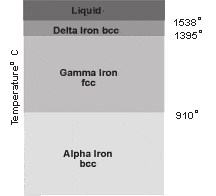 |
|
| Iron, carbon, and alloys |
|
The Lattice structure At room temperature, the atoms of iron bond together in a structure know as a lattice. Picture 1a is an example of this structure, which is known as a body centered cubic (bcc). When iron is heated to 910º C, it undergoes what is known as a phase change. Its lattice structure is fundamentally changed and now looks like picture 1b. This is known as a face centered cubic (fcc) structure. The ability for an element like iron to exist in more than one structure is one of two fundamental principles in the understanding of steel. The role of carbon Carbon is the principle alloying element that transforms soft iron into hard and useful steel. In fact, unless the carbon content in steel is greater than .2%, the steel will not even harden. The concept of substitution allows atoms of carbon to join into the lattice structure of iron.
Alloys The mixture of the elements iron and carbon create what is known as an alloy, and it is much harder and stronger than pure iron. Carbon and many other elements can be combined with iron to form various types of alloys, all of which are referred to as steel. |


 The
The